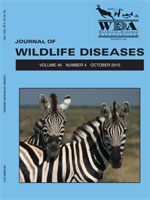Host-parasite systems have often evolved over time, such that infection dynamics may become greatly modified from the time of initial contact of the host with the parasite. Biological invasions may be useful to clarify processes in the initial contact of hosts with parasites, and allow us to compare parasite uptake between the ancestral (coevolved) host and novel (noncoevolved) hosts. Cane toads (Bufo marinus) are spreading rapidly through tropical Australia, carrying with them a nematode lungworm (Rhabdias pseudosphaerocephala) congeneric with those found in Australian frogs. We investigated the dynamics of infections of the toad parasite by conducting histologic examinations of cane toads and three native Australian frogs (Litoria dahlii, Litoria nasuta, and Opisthodon ornatus) at 2, 6, and 10 days after experimental exposure to the toad lungworm. More worms were found in toads than in frogs, especially at longer periods postexposure. In toads, the infective larvae entered the skin and muscles within 2 days postexposure, passed into the coelom in 6 days, and reached the lungs at 10 days. In frogs, larvae were found in many organs rather than migrating to consistent target tissues; a few larvae reached the lungs of L. dahlii. Migratory larvae caused increasing inflammation (primarily granulomatous admixed with granulocytes then lymphocytes) through time, especially in frogs. Evolution has resulted in an enhanced ability of the lungworm to locate the target organ (the lungs) of the toad, and an increase in rates of parasite survival within this host.
How to translate text using browser tools
1 October 2010
INFECTION DYNAMICS OF THE LUNGWORM RHABDIAS PSEUDOSPHAEROCEPHALA IN ITS NATURAL HOST, THE CANE TOAD (BUFO MARINUS), AND IN NOVEL HOSTS (NATIVE AUSTRALIAN FROGS)
Ligia Pizzatto,
Catherine M. Shilton,
Richard Shine
ACCESS THE FULL ARTICLE

Journal of Wildlife Diseases
Vol. 46 • No. 4
October 2010
Vol. 46 • No. 4
October 2010
Anura
host switch
immunologic response
Inflammation
migratory pathway
nematode
parasite




